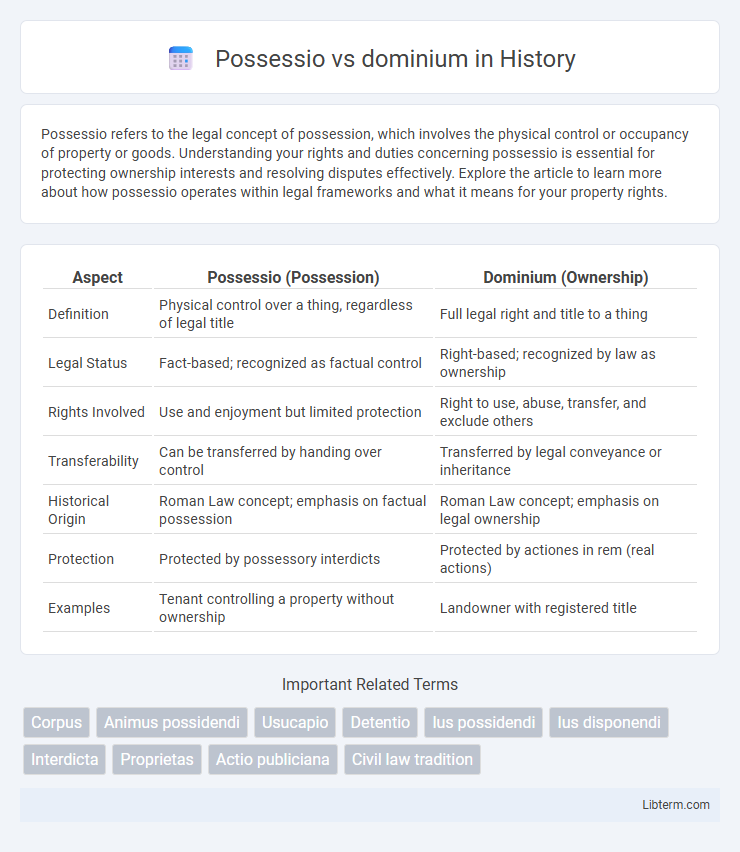Possessio refers to the legal concept of possession, which involves the physical control or occupancy of property or goods. Understanding your rights and duties concerning possessio is essential for protecting ownership interests and resolving disputes effectively. Explore the article to learn more about how possessio operates within legal frameworks and what it means for your property rights.
Table of Comparison
| Aspect | Possessio (Possession) | Dominium (Ownership) |
|---|---|---|
| Definition | Physical control over a thing, regardless of legal title | Full legal right and title to a thing |
| Legal Status | Fact-based; recognized as factual control | Right-based; recognized by law as ownership |
| Rights Involved | Use and enjoyment but limited protection | Right to use, abuse, transfer, and exclude others |
| Transferability | Can be transferred by handing over control | Transferred by legal conveyance or inheritance |
| Historical Origin | Roman Law concept; emphasis on factual possession | Roman Law concept; emphasis on legal ownership |
| Protection | Protected by possessory interdicts | Protected by actiones in rem (real actions) |
| Examples | Tenant controlling a property without ownership | Landowner with registered title |
Introduction to Possessio and Dominium
Possessio refers to the actual control or physical holding of property, emphasizing the factual state of possession without necessarily implying legal ownership. Dominium denotes full legal ownership, encompassing the rights to use, enjoy, and dispose of the property. Understanding the distinction between possessio and dominium is crucial in property law, as possessio protects possession itself, while dominium protects ownership rights.
Historical Background of Possession and Ownership
Possessio and dominium originate from Roman law, where possessio referred to physical control or occupation of property, while dominium denoted full legal ownership and rights over the asset. Historically, possessio was recognized for protecting the possessor's interest even without formal ownership, serving as a factual possession that could lead to dominium through prolonged, uncontested control. The distinction guided modern property laws by balancing tangible control with legal title, shaping possession and ownership's legal frameworks worldwide.
Defining Possessio: Legal Meaning and Scope
Possessio refers to the actual control or physical holding of a property, distinct from dominium, which signifies full legal ownership rights. Possessio encompasses the power to use, enjoy, and exclude others from the property, even without formal title or ownership. The scope of possessio includes both corporeal possession, such as holding land or goods, and incorporeal possession, reflecting control over rights or claims associated with the property.
Understanding Dominium: Concept and Significance
Dominium refers to the ultimate ownership right over property, encompassing the authority to use, enjoy, and dispose of it. This legal concept grants the owner absolute control, distinguishing it from possessio, which is the actual control or custody of the property without necessarily implying ownership. Understanding dominium is crucial in property law, as it determines the rightful owner's entitlement and the extent of their legal protection against third parties.
Key Differences Between Possessio and Dominium
Possessio refers to the physical control or occupation of a property without necessarily having legal ownership, while dominium denotes the full legal ownership rights over that property, including the right to use, exclude others, and transfer ownership. Possessio can exist without dominium, such as in cases of tenants or possessors in good faith, whereas dominium inherently implies both legal title and exclusive control. The key difference lies in possessio being a factual state of control, whereas dominium is a legal right recognized and protected by law.
Legal Implications of Possession
Possessio refers to the physical control or occupancy of a property, while dominium signifies full legal ownership rights. Legal implications of possession include the protection of possessory rights through possessory actions, which safeguard possessors against unlawful dispossession even without proving ownership. Courts often recognize possessio as a basis for certain rights like usufruct or acquisition by prescription, emphasizing its significance in property disputes and transfer of ownership.
Rights and Duties under Dominium
Dominium represents full ownership rights, encompassing both the right to use and dispose of property, as well as the duty to respect legal restrictions and community regulations. Rights under dominium include the ability to transfer ownership, modify, or exclude others from the property, while duties involve maintaining the property and avoiding harm to neighbors or public interests. Unlike possessio, which primarily involves physical control, dominium confers comprehensive legal authority and responsibilities over the asset.
Transfer of Possessio and Dominium
Transfer of possessio involves the physical delivery or control of an object without necessarily transferring ownership rights, emphasizing actual possession. Transfer of dominium, by contrast, legally conveys full ownership rights and title, often requiring formal agreements or compliance with statutory requirements. Distinguishing these concepts is critical in property law, as dominium confers authority to use, modify, or alienate an asset, whereas possessio pertains solely to custody or control.
Modern Applications in Civil Law
In modern civil law, possessio refers to the physical control or occupation of a property without necessarily holding legal ownership, while dominium represents full legal ownership and the associated rights to use, transfer, and exclude others. Courts often protect possessio through possessory actions to maintain public order, even if the possessor lacks dominium, emphasizing possession's practical importance. Contemporary property disputes frequently hinge on distinguishing possessio from dominium, influencing remedies such as eviction, restitution, or transfer of title in jurisdictions worldwide.
Conclusion: The Role of Possessio vs Dominium Today
Possessio and dominium represent distinct legal concepts where possessio refers to physical control or possession of property, while dominium signifies the ultimate legal ownership or title. In contemporary property law, possessio often serves as evidence or a prerequisite to claiming dominium, especially in cases involving adverse possession or disputes over rightful ownership. The role of possessio remains crucial in establishing facts on the ground, but dominium ultimately governs the legal rights and transferability of property.
Possessio Infographic

 libterm.com
libterm.com